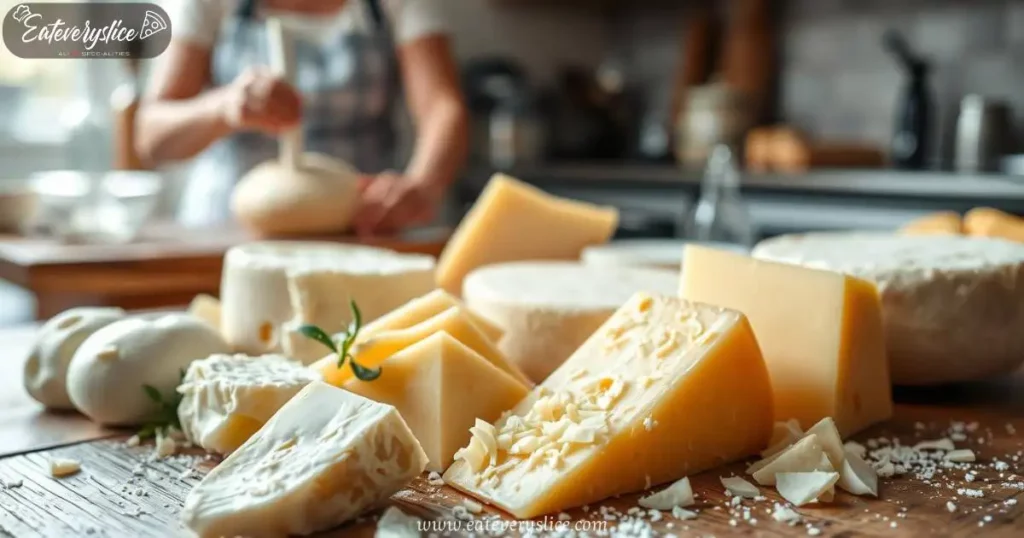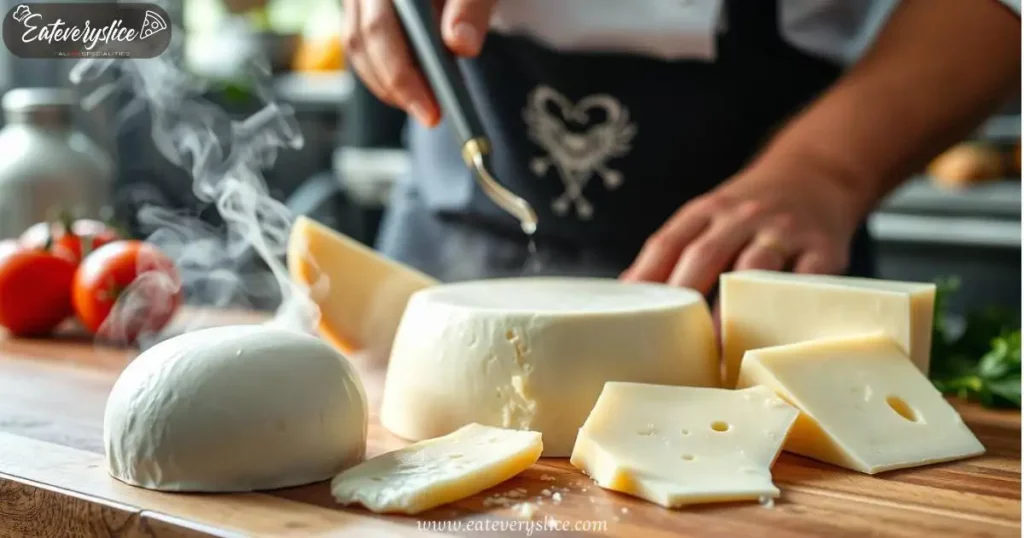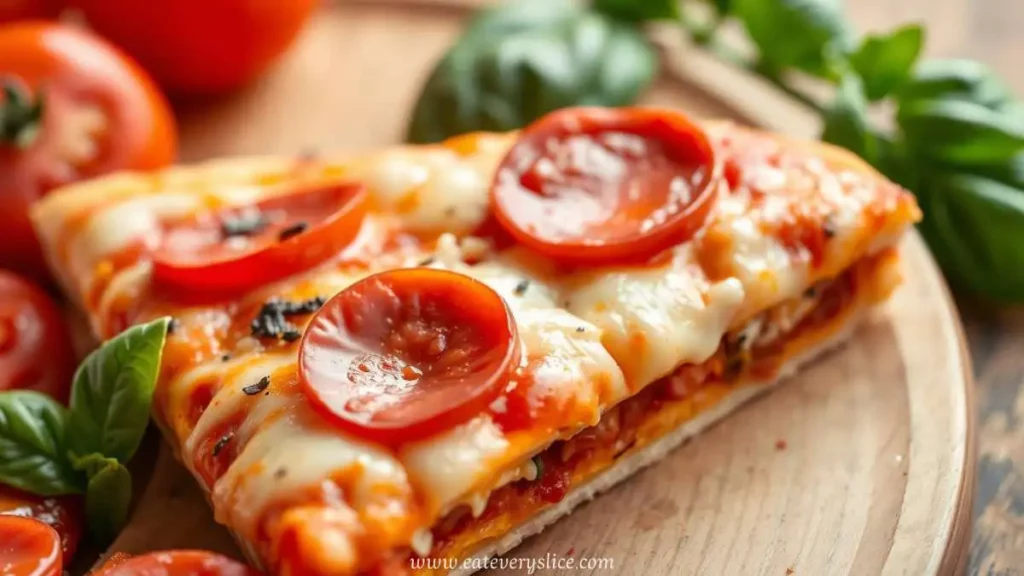Last updated on March 30th, 2025 at 07:27 am
Table of Contents
The recipe
Homemade Pizza Cheese

Find the best pizza cheese for your pie and learn what cheese goes on pizza for the perfect flavor combination.
Type: Cheese
Cuisine: Italian-American
Keywords: Homemade pizza cheese, Best cheese for pizza, DIY mozzarella cheese, Stretchy pizza cheese, Cheese for Italian pizza
Recipe Yield: 1 pound of pizza cheese (enough for 2-3 medium pizzas)
Calories: 90 calories
Preparation Time: PT10M
Cooking Time: PT15M
Total Time: PT25M
Recipe Ingredients:
- 1 gallon whole milk (preferably not ultra-pasteurized)
- 1/4 cup white vinegar or lemon juice
- 1/2 teaspoon salt (adjust to taste)
- 1/4 teaspoon liquid rennet (available online or in specialty stores)
- Optional: 1 teaspoon dried Italian herbs or garlic powder for extra flavor
Listen to the Podcast

December 8, 2024 · Season 1 : Season 1: Slice by Slice · Episode 1
3 Min · By Zac
Find the best pizza cheese for your pie and learn what cheese goes on pizza for the perfect flavor combination | Eat Every Slice
Step-by-Step Instructions
- Heat the Milk:
- Pour the whole milk into a large pot. Heat gently over medium heat until it reaches 85°F (29°C). Use a kitchen thermometer for accuracy.
- Add the Vinegar or Lemon Juice:
- Stir in the vinegar or lemon juice slowly. This will help the milk curdle and form curds.
- Add the Rennet:
- Stir in the liquid rennet and let the mixture sit undisturbed for 5-10 minutes. You’ll notice the milk solidify into curds.
- Slice the Curds:
- Slice the curds into small cubes using a long knife. Heat the mixture to 105°F (40°C) while stirring gently.
- Drain the Whey:
- Transfer the curds and whey into a strainer lined with cheesecloth, letting the whey drain for approximately 10 minutes.
- Knead and Stretch the Cheese:
- Place the curds into a bowl and microwave for 30 seconds. Knead the cheese with your hands or a spoon. Repeat microwaving and kneading 2-3 times until the cheese becomes smooth and stretchy.
- Season the Cheese:
- Sprinkle salt and optional Italian herbs or garlic powder over the cheese and knead until fully incorporated.
- Shape and Chill:
- Form the cheese into a ball, wrap it in plastic wrap, and refrigerate for at least 1 hour before using.
Summary
This homemade pizza cheese recipe is a game-changer for pizza lovers. It’s fresh, customizable, and delicious, perfect for achieving that classic stretchy texture you love on pizza. Pair it with your favorite crust and toppings, and enjoy the compliments!
For the reading lovers:
Imagine gathering with loved ones, the smell of pizza baking fills the air. It brings back memories of happy times. The cheese melting on top is what makes pizza nights special.
Choosing the right cheese is key to a great pizza. This guide will show you the best cheeses for flavor and that perfect cheese pull. Whether you’re making a classic or something new, knowing about each cheese will help you make the best pizza every time.

Key Takeaways
- The right pizza cheese influences flavor, texture, and overall enjoyment.
- Fresh mozzarella is celebrated for its rich, milky taste and ideal meltability.
- Pairing different cheeses can enhance flavors and textures in your pizza.
- Low-moisture mozzarella is a favorite for its drier texture and consistent cooking.
- Organic and artisanal cheese options can offer premium quality and distinct flavors.
The Importance of Cheese in Pizza
Cheese is key in pizza, adding flavor and a creamy texture. Mozzarella is the top choice because it stretches well and tastes mild. It’s the perfect base for tomato sauce and toppings, making every bite a delight.
Cheese pizza is good for you, too. The USDA says it has protein, calcium, and more, helping you stay healthy. It’s simple: just tomato sauce, cheese, and dough. This combo is loved worldwide.
Getting the right cheese and toppings balance is important. Try different pizzas like Margherita or BBQ Chicken to see what works. Use fresh dough and high-quality cheese, like shredded, for the best taste.
To get a crispy crust, bake on a pizza stone. It makes the crust better and brings families together. Making pizza is a fun way to create lasting memories.
| Cheese Type | Moisture Content | Fat Content (per 1 oz.) | Flavor Profile |
|---|---|---|---|
| Mozzarella | High (52%-60%) | 4.8 grams | Mild and creamy |
| Provolone | High (45%) | 7 grams | Sweet when young; sharp when aged |
| Cheddar | Medium (34%-45%) | 9 grams | Sharp and earthy |
| Parmesan | Low (13%-34%) | – | Nutty and salty; best used as topping |
| Gouda | Medium to High (35%-55%) | 8 grams | Buttery and smokey |
| Goat Cheese | Medium | – | Soft and creamy |
Knowing how cheese works with other ingredients makes pizza-making fun. It lets you create pizzas that everyone will love.
Understanding Meltability and Stretchability
Creating the perfect pizza involves meltability and stretchability of cheese. Meltability shows how cheese changes when heated. Stretchability is about forming long strands that add to the fun of eating.
Softer cheeses, like mozzarella, melt and stretch well. This makes them perfect for that *gooey pizza cheese* texture everyone loves.
High moisture cheeses melt better. Young Gouda and mozzarella have more water, making them gooey. Aged cheddar, on the other hand, stretches less but adds flavor.
Fat content also matters. Havarti melts better because of its fat. But low-fat mozzarella stretches less.
As cheese ages, its meltability and stretchability change. Proteins break down, affecting these traits. This means older cheeses might not stretch as well.
Acid content and how milk is treated also matter. Cheeses with little acid melt poorly. But those with balanced acid melt well. Choosing the right cheese mix is key to a great pizza.

Top Cheeses for Your Pizza
Choosing the right cheese is key to making a great pizza. Each type brings its own taste and texture. These can make your pizza special. Here are some top cheeses to try for your next mozzarella cheese pizza.
Mozzarella: The Classic Choice
Mozzarella is the top pick for pizza. It melts well and tastes mild. It’s perfect with many toppings. This cheese is a must in Neapolitan pizza, loved by all.
Low-Moisture vs. Fresh Mozzarella
Choosing between low-moisture and fresh mozzarella changes your pizza. Fresh mozzarella tastes creamy but can make the crust soggy. Low-moisture mozzarella is better for a crispy crust and golden melt.
Cheddar: Adding Depth and Flavor
Cheddar cheese has a sharp, rich taste. It’s not the main cheese but adds depth when mixed with mozzarella. This mix makes your pizza more flavorful and satisfying.

| Cheese Type | Flavor Profile | Meltability | Best Use |
|---|---|---|---|
| Mozzarella | Mild and creamy | High | Classic pizza |
| Low-Moisture Mozzarella | Saltier, denser | High | Ideal for pizza |
| Fresh Mozzarella | Rich and creamy | Moderate | Gourmet pizzas |
| Cheddar | Sharp and rich | Lower | Flavor blends |
Artisanal and Gourmet Pizza Cheeses
Choosing the right cheese can make your pizza special. Artisanal cheeses add unique flavors and textures. Here are three cheeses that can take your pizza to the next level.
Buffalo Mozzarella: A Premium Option
Buffalo mozzarella is a top pick for pizza. It’s made from water buffalo milk, giving it a creamy texture and rich taste. It melts well, making your pizza taste amazing.
Many chefs love it for its ability to enhance both classic and modern pizzas.
Pepper Jack: For a Spicy Kick
Pepper jack cheese adds a spicy kick to your pizza. It’s a mix of mild cheddar and spicy peppers. This cheese is great for those who like a little heat.
It’s perfect for adding excitement to your favorite pizza toppings.
Ricotta: Creamy and Versatile
Ricotta cheese brings a creamy touch to pizzas. It doesn’t melt like other cheeses but adds moisture and richness. It’s great for lighter toppings or white pizzas.
Its mild flavor pairs well with many ingredients, making it versatile for different pizza styles.

| Cheese Type | Texture | Flavor Profile | Best For |
|---|---|---|---|
| Buffalo Mozzarella | Creamy | Rich and buttery | Gourmet pizzas |
| Pepper Jack | Soft | Spicy with a mild cheddar base | Spicy pizzas |
| Ricotta | Creamy | Mild | White pizzas and lighter toppings |
Organic and Low-Fat Pizza Cheese Alternatives
Looking into cheese options can lead to tasty and healthy discoveries. Organic and low-fat pizza cheese alternatives offer great benefits. They cater to different diets while keeping the flavor delicious.
The Benefits of Choosing Organic
Organic pizza cheese is free from artificial ingredients. It comes from farms that care for animals better. This cheese often tastes richer than regular cheese.
Organic cheese is a healthy choice. It lets you enjoy your favorite meals without feeling guilty.
Exploring Low-Fat Options
Low-fat pizza cheese is perfect for those watching their calories. It’s made from reduced-fat milk and melts well. You can make tasty pizzas with your favorite toppings while eating healthier.
| Brand | Type | Calories/28g | Fat/28g | Sodium/28g | Price/28g |
|---|---|---|---|---|---|
| Miyoko’s Liquid Vegan Pizza Mozzarella | Vegan | 70 | 6 g | 220 mg | $0.43 |
| Miyoko’s Organic Cashew Milk Mozzarella | Organic | 60 | 5 g | 210 mg | $1.11 |
| Follow Your Heart Vegan Shredded Mozzarella | Vegan | 80 | 7 g | 230 mg | $0.74 |
| Violife Just Like Mozzarella Shreds | Vegan | N/A | N/A | N/A | N/A |

Combining Different Cheeses for Flavor
Exploring cheese blends opens a world of flavors. It’s about mixing cheeses that melt well and taste great together. This makes your pizza special, setting it apart from others.
The Art of Cheese Blends
Cheese blends can make your pizza taste amazing. You might use mozzarella, provolone, and Parmesan. These cheeses melt well and add richness to your pizza.
Knowing how cheeses melt is key. It lets you create unique pizzas that everyone will love.
Listen to the Podcast
Suggested Cheese Combinations
Trying different cheese mixes can be fun. Here are some ideas:
- Mozzarella, Romano, and Parmesan make a tasty white pizza.
- Fontina and Gruyère add a fancy touch to gourmet pizzas.
- Mozzarella and cheddar mix for great flavor and stretchiness.
- Cheddar with other cheeses adds depth without being too strong.
Now, you can find cheese blends made just for you. Using a special cheese blend can make your pizza stand out.
Remember, too many cheeses can be too much. But with so many options, you can make pizzas that everyone will love.
| Cheese Blend | Flavor Characteristics | Best Used For |
|---|---|---|
| Mozzarella, Provolone, Parmesan | Rich and stretchy | Traditional pizzas |
| Mozzarella, Romano, Parmesan | Sharp and tangy | White pizzas |
| Fontina, Gruyère | Complex and nutty | Gourmet pizzas |
| Mozzarella, Cheddar | Stringy with depth | All styles |
Try these cheese blends to make your perfect pizza. Your customers will love the unique flavors you offer.
Preparation Tips for Perfect Pizza Cheese
Creating the ultimate pizza experience requires careful attention to cheese preparation. To get the best flavor, texture, and melt, follow these tips.
Always Shred Your Own Cheese
For the best taste and melt, shred your own cheese. Pre-shredded cheese often has additives that can ruin the flavor and melt. Shredding your own cheese ensures each pizza slice is cheesy and satisfying. Freshly shredded cheese melts better and improves your pizza’s texture.
Moisture Management for Fresh Cheeses
Managing moisture is key when using fresh cheeses. Mozzarella, for example, can make your pizza soggy if not dried properly. Before using fresh mozzarella, pat it dry or let it air out for a bit. This step helps control moisture, leading to a perfectly baked pizza. Keeping moisture levels right is crucial for making great pizza cheese.

Pizza Cheese and Dietary Considerations
Knowing about dietary restrictions can change how you enjoy pizza. There are gluten-free pizza cheese options for those with gluten sensitivities. This way, everyone can have a great pizza without worrying about their health.
Gluten-Free Pizza Cheese Options
Many brands offer gluten-free pizza cheeses like mozzarella and cheddar. These cheeses don’t have gluten. Just check the labels for the gluten-free mark to be sure.
Vegan cheese alternatives are also a good choice. They’re perfect for those on a plant-based diet or with lactose intolerance. These cheeses come from nuts, soy, or coconut and taste great.
Being aware of different diets makes dining more fun for everyone. With gluten-free cheese and vegan options, pizza can be enjoyed by all. No one has to miss out on the fun.
Utilizing Premium Pizza Cheese Products
Premium pizza cheese products can make your homemade pizza better. These cheeses add new flavors and textures that excite your taste buds. They let you try out creative pizza recipes that rival your favorite pizzerias.
These cheeses are also good for you. They have 80 to 100 calories per serving. The fat content is 6g to 8g, with saturated fat between 3.5g and 4.5g. Cholesterol is 20mg to 30mg, and sodium is 180mg to 200mg.
Each cheese has 6g of protein and 182mg to 197mg of calcium. This is great for your bones.
Shredded mozzarella is the most popular cheese for pizza. It’s easy to spread on the crust. Sliced mozzarella is great for deeper-dish pizzas. Diced mozzarella gives a fun twist to traditional pizza.
| Cheese Type | Calories | Fat (g) | Saturated Fat (g) | Cholesterol (mg) | Sodium (mg) | Protein (g) | Calcium (mg) |
|---|---|---|---|---|---|---|---|
| Shredded Mozzarella | 80-100 | 6-8 | 3.5-4.5 | 20-30 | 180-200 | 6 | 182-197 |
| Sliced Mozzarella | 80-100 | 6-8 | 3.5-4.5 | 20-30 | 180-200 | 6 | 182-197 |
| Diced Mozzarella | 80-100 | 6-8 | 3.5-4.5 | 20-30 | 180-200 | 6 | 182-197 |
Using these premium cheeses lets you make pizzas that taste amazing and are good for you. Try different combinations to find new flavors. Your kitchen will become a place where everyone wants to eat.
Conclusion
Choosing the right cheese for your pizza is key to making the perfect slice. This guide helps you pick the best cheese, from classic mozzarella to gourmet options. By trying different cheeses, you can make your homemade pizza truly special.
Cheese is the heart of a pizza, adding flavor and texture. Whether it’s creamy mozzarella or tangy cheddar, every cheese brings something special to your pizza. Get creative and experiment with different cheeses to discover bold new flavors!
With the right cheese, your pizza can become a masterpiece. Great pizza starts with simple ingredients. The best cheese is the one that turns every bite into a memorable experience.
FAQ
What is the best cheese for pizza?
Mozzarella is the top pick for u003ca href=u0022https://en.wikipedia.org/wiki/Pizza_cheeseu0022 target=u0022_blanku0022 data-type=u0022linku0022 data-id=u0022https://en.wikipedia.org/wiki/Pizza_cheeseu0022 rel=u0022noreferrer noopeneru0022u003epizza cheeseu003c/au003e. It melts well and stretches beautifully. Low-moisture mozzarella is especially good for that gooey texture everyone loves.
Can I use other types of cheese on my pizza?
Absolutely! You can mix it up with cheeses like cheddar, u003cstrongu003ebuffalo mozzarellau003c/strongu003e, ricotta, and pepper jack. They add different flavors and textures to your pizza.
What is the difference between fresh and low-moisture mozzarella?
Fresh mozzarella is creamier because it has more moisture. Low-moisture mozzarella is denser and melts better, making your crust golden without getting soggy. Each has its own benefits for your pizza.
Are there any organic or low-fat cheese alternatives for pizza?
Yes, there are organic and low-fat cheese options. They’re free from artificial stuff and made with healthier ingredients. They taste great and are better for you.
How can I create a cheese blend for my pizza?
Start by picking cheeses that melt well and taste good together. Mozzarella and provolone are great for stretchiness. Or try sharp cheddar with creamy mozzarella for more flavor.
Should I shred my own cheese for pizza?
Always u003cstrongu003eshred your own cheeseu003c/strongu003e. Pre-shredded cheese often has additives that mess with melt and taste. It’s better for your pizza.
What should I do to manage moisture when using fresh cheese?
To avoid a soggy crust, manage moisture. Pat down fresh cheese or let it dry a bit before putting it on your pizza.
Are there gluten-free cheese options for pizza?
Yes, there are many gluten-free cheese options. Most natural cheeses are safe for those with gluten issues.
What makes premium pizza cheese products special?
Premium cheese is made with top-notch ingredients. It offers better flavors and textures. Using these cheeses can make your homemade pizza taste like it’s from a pizzeria.






